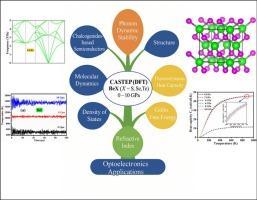揭示BeX (X = S, se和Te)的高压研究:基于DFT的声子光谱,分子动力学,光学响应和热力学稳定性的探索,用于先进的光电应用
IF 4.6
3区 材料科学
Q2 MATERIALS SCIENCE, MULTIDISCIPLINARY
引用次数: 0
摘要
在本研究中,我们重点研究了BeX (X = S, Se, Te)在静水压力从0到10 GPa变化时的结构、电子、光学和热力学性质。利用CASTEP代码通过广义梯度近似(GGA)和Perdew-Burke-Ernzerhof泛函(PBE)进行计算。通过声子色散研究证明,这三种化合物在所有施加压力下都保持其动态稳定性,因为在布里渊区到处都没有虚频率。我们的研究表明,压力使所研究的所有材料都产生应力,并且BeS仍然保持普遍的电子带隙。详细研究了光子能量小于30 eV时的介电函数、吸收光谱、反射率和能量损失等光学特性。光学吸收光谱分析表明,在紫外区有显著的光学活性,最大的光子吸收发生。此外,还研究了材料的德拜温度、热容和熵等热力学性质。当压力升高时,原子的运动减少,因此热容减小。当压力恒定时,吉布斯自由能曲线的斜率略微倾斜,这表明熵随温度的稳定变化。研究结果证实,BeX (X = S, Se, Te)具有增强的热力学性质,并在光电子,热电和热障,特别是压力依赖性光电子器件中有很好的应用前景。本文章由计算机程序翻译,如有差异,请以英文原文为准。

Unveiling high-pressure investigation of BeX (X = S, se, and Te): A DFT- base exploration of phonon spectra, molecular dynamics, optical responses, and thermodynamic stability for advance optoelectronic applications
In this study, we focus on the structure, electronic, optical and thermodynamic properties of BeX (X = S, Se, Te) under hydrostatic pressure changes from 0 to 10 GPa. The computations were made through the Generalized Gradient approximation (GGA) and Perdew-Burke-Ernzerhof functional (PBE) utilizing the CASTEP code. It was demonstrated through phonon dispersion studies that the three compounds maintain their dynamic stability at all applied pressures because imaginary frequencies were absent everywhere in the Brillouin zone. Our study revealed that pressure puts stress on all the materials studied and BeS still maintains the prevalent electronic bandgap. Different optical properties such as dielectric functions, absorption spectra, reflectivity and energy loss, were studied in detail for photon energies less than 30 eV. Analysis of optical absorption spectra indicates significant optical activity with maximum photon absorption occurring in UV region. Furthermore, thermodynamic properties like Debye temperature, heat capacity and entropy were studied. When the pressure goes up, atoms move less and therefore heat capacity decreases. When there is constant pressure, the slope of the Gibbs free energy curve tilts slightly greater which reveals a steady variation of entropy with temperature. The findings confirm that BeX (X = S, Se, Te) has enhance thermodynamic properties and Suggest promising applications in optoelectronics, thermoelectric and thermal barriers, especially in pressure dependent optoelectronic devices.
求助全文
通过发布文献求助,成功后即可免费获取论文全文。
去求助
来源期刊

Materials Science and Engineering: B
工程技术-材料科学:综合
CiteScore
5.60
自引率
2.80%
发文量
481
审稿时长
3.5 months
期刊介绍:
The journal provides an international medium for the publication of theoretical and experimental studies and reviews related to the electronic, electrochemical, ionic, magnetic, optical, and biosensing properties of solid state materials in bulk, thin film and particulate forms. Papers dealing with synthesis, processing, characterization, structure, physical properties and computational aspects of nano-crystalline, crystalline, amorphous and glassy forms of ceramics, semiconductors, layered insertion compounds, low-dimensional compounds and systems, fast-ion conductors, polymers and dielectrics are viewed as suitable for publication. Articles focused on nano-structured aspects of these advanced solid-state materials will also be considered suitable.
 求助内容:
求助内容: 应助结果提醒方式:
应助结果提醒方式:


